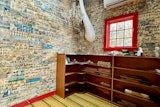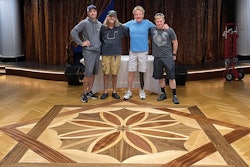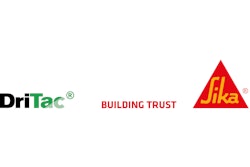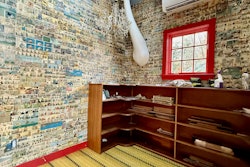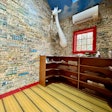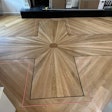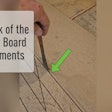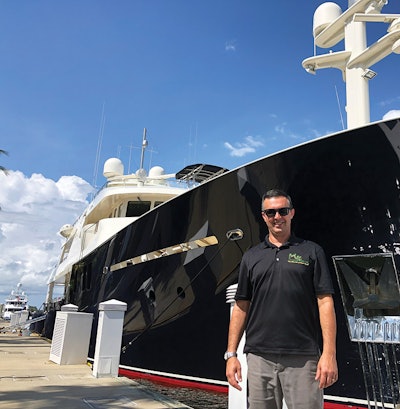
In our market in southern Florida, we deal with wealthy customers with lavish homes on a routine basis. But one part of our business is so far from routine, it isn't even on land. Southern Florida is one of the top areas in the world for yachting, and we regularly do wood flooring jobs on yachts and superyachts. Not surprisingly, these jobs can't be done like a typical wood flooring job. Here are some of the top things we've learned that make these amazing job sites different.
Everybody respects your job.
A main thing that makes yacht work totally different from a typical wood flooring job is that on a yacht, everybody respects your job. If they set up a time for you to do the work for the entire week, nobody's going to be in that area and there won't be any other trades on top of you. In fact, people are assigned to show up to meet you and show you the area where you will be working, how to get in and out of the yacht, where to get power, etc., etc. It's all organized and delegated in the correct way, which makes it different from a regular wood flooring job! One exception can be if the yacht is in dry dock (more on that later).
They are used to frequent maintenance.
It's common for us to do the same vessel multiple times, and people with yachts expect their vessels to have continual maintenance done, including on the wood floors. They might go out on a trip and get in a little storm, and if they hit a big wave while they are cooking something heavy can fly off the counter, or they open the refrigerator and things fall out and dent the wood floor. They aren't necessarily going to be doing continual board replacements, but when they come back to port they'll have someone who specializes in disguising dings and dents come do touchups, and then we'll recoat the floor. In fact, that's how I first began doing yacht work: My colleague Thomas Anthony, the owner/operator at Thomas Anthony Furniture Service, handles furniture and wall repairs out of Deerfield Beach, Fla., and he asked me if we would be interested in handling the wood floor work.
At the end of the day, the owner or whoever is chartering this yacht wants to see this vessel nice and clean and sharp. Will it have dings and dents? Yes, but they won't let it go too far. Even if the boat is just sitting at the dock, the crew will be washing the decks and fiberglass all day long on these boats; it never ends.
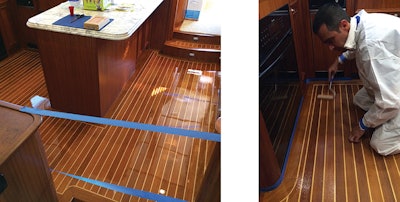 In this photo I'm rolling on the oil-modified Interlux Goldspar marine finish that the client requested; we use the 'roll and tip' method for application where we roll the finish and then immediately smooth it with a brush. I don't have my hood on here, but usually when we are coating on a yacht I wear this suit with the hood on to reduce any potential of getting hairs or fibers in the finish. This yacht has the traditional design for yacht flooring, although many new yachts today follow the same design trends you find in a home.
In this photo I'm rolling on the oil-modified Interlux Goldspar marine finish that the client requested; we use the 'roll and tip' method for application where we roll the finish and then immediately smooth it with a brush. I don't have my hood on here, but usually when we are coating on a yacht I wear this suit with the hood on to reduce any potential of getting hairs or fibers in the finish. This yacht has the traditional design for yacht flooring, although many new yachts today follow the same design trends you find in a home.
You aren't bringing in a lot of equipment or tools.
Even if I'm doing 200 or 300 square feet, I'm not bringing in a big machine or edger. The job is all done on hands and knees sanding with our Festool orbital sanders—all with vacuums—and the edges are hand-scraped. It sounds like a strange way to describe it, but the job is nice and slow, taking every precaution to not make a mark on baseboards or walls, because all the materials that go into a yacht are very expensive, and everything matches everything, so doing a repair could be extremely expensive. We won't even bring a backpack vacuum on board because of the risk of hitting something with it.
In regular wood flooring jobs, you are used to rooms being a minimum of 100 or 115 square feet, but on a yacht you might be doing that total between three different rooms, so you don't have space to keep most of your tools with you where you are working. Instead, you leave everything in a designated area or at the dock and go out to get it as you need it, then take it back out as soon as you are done. If you leave tools on the dock, you have to keep in mind that the dock moves, too. If you leave your hand truck out there like you normally would, you might not find it later! Normally when working on a dock we put the hand truck handle down, not wheels down, so we don't end up with tools overboard.
Of course, in the event that you leave any tools on the deck of the vessel itself, the deck must be protected. You don't want to damage the vessel, and you have to keep in mind that it's always moving.
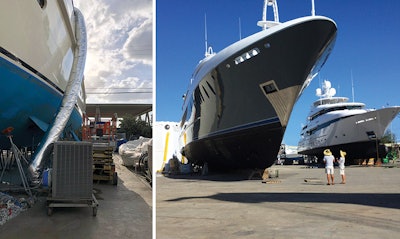 When yachts are in dry dock you really get a sense of how huge they are. I try to avoid working on yachts when they are in dry dock as opposed to being in the water, because the usual HVAC systems are not operational and there are usually many trades trying to get things done as quickly as possible—more like a typical job site. In the photo at left you can see the temporary HVAC system they use during dry dock; it's basically like a regular household AC system on wheels that's run in through a door or window.
When yachts are in dry dock you really get a sense of how huge they are. I try to avoid working on yachts when they are in dry dock as opposed to being in the water, because the usual HVAC systems are not operational and there are usually many trades trying to get things done as quickly as possible—more like a typical job site. In the photo at left you can see the temporary HVAC system they use during dry dock; it's basically like a regular household AC system on wheels that's run in through a door or window.
Nobody wears shoes inside a yacht.
When you arrive at a yacht, the first thing you do is take off your shoes and put them in a basket, even if you are working. Maybe if you are ripping out a floor you will have an exception, because they don't want you to get hurt, but on a refinish or recoating job, typically everyone is in their socks.
Demo work is very slow.
On regular wood flooring jobs, when we do demo we are using brute force and just getting it done—the sooner, the better. On a yacht, demo is a much slower, careful process. First of all, you have to plastic over everything and protect everything, putting air filters on your returns. On a job where the captain and crew were still living on the vessel during demo, we also used an air scrubber to remove dust as we worked.
On a yacht, every single time you make a cut on an existing floor, you have to be sure you aren't going to cut a cable line, electrical line or anything else right below the surface that would make it a much longer, expensive project. For any cuts, you go ask the captain: Is there anything there? Can I cut there? How deep can I cut? They normally have prints for everything inside the vessel, and if they don't, they will tell you to stop work that day because they have to call the manufacturer of the vessel to pull the prints and find the relevant info.
 It's very unusual for us to have any sanding equipment besides a palm sander on a yacht, but this was an extremely large boat and someone had used a refresher type of product on the floors. We used the Basic Coatings system to remove the refresher and recoat the floor, but we used the buffer instead of the scrubber. Obviously we had to be extremely careful while buffing since the furnishings and art were all still in place!
It's very unusual for us to have any sanding equipment besides a palm sander on a yacht, but this was an extremely large boat and someone had used a refresher type of product on the floors. We used the Basic Coatings system to remove the refresher and recoat the floor, but we used the buffer instead of the scrubber. Obviously we had to be extremely careful while buffing since the furnishings and art were all still in place!
Yacht subfloors are different.
On my first yacht job, I was working with my brother, Evandro. They had a water leak on the yacht and called us to see what we could do for the damaged wood floor. We ended up tearing out the entire wood floor and were surprised to see that the subfloor was fiberglass. Of course these boats are created from wood trusses covered in fiberglass, so subfloors are fiberglass or plywood installed over metal I-beams. On that first job we put a ⅝-inch plywood subfloor down with Sika T55, which has enough elasticity for the humidity these floors endure. Then we glued the floor on top of that with the same adhesive.
Many times they don't have baseboards.
Many yachts don't have baseboards, or if they do they keep a ¼-inch or ⅜-inch gap all the way around and fill that in with rubber caulking or just regular caulking for expansion and contraction. Everything installed on a yacht has to be chosen keeping in mind the fact that it's a boat, and it's going to move and twist just going through the waves, so nothing can be rigid against the perimeter of the floor.
On the boat decks, many people think those are two woods being used, but on the outside decks most of the time the deck is wood alternating with ¼-inch rubberized caulking so it can get wet, flex and expand and contract.
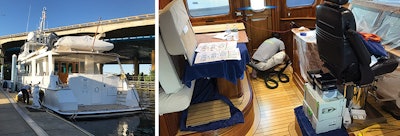 This is a smaller yacht, and in the photo of me working you get a good sense of how cramped and cut-up the jobs usually are on a yacht.
This is a smaller yacht, and in the photo of me working you get a good sense of how cramped and cut-up the jobs usually are on a yacht.
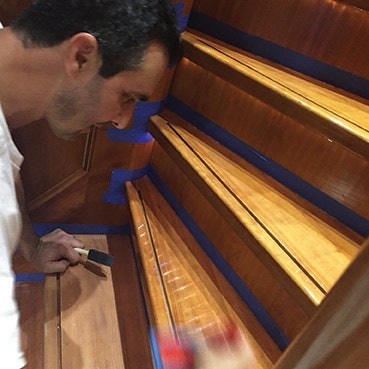 In the stairs on this yacht they had a small rubber inlaid piece in the front of the treads; we had to remove those and be careful to not fill in the void so it could be re-inserted.
In the stairs on this yacht they had a small rubber inlaid piece in the front of the treads; we had to remove those and be careful to not fill in the void so it could be re-inserted.
They expect to have lots of finish coats.
People with yachts are used to having many layers of coats; they like the buildup. The traditional look for finish on the boats was many layers with a high-gloss finish; today some boats still have that look, but in general, finish trends on yachts follow the same trends as you see in a home, so we use a lot of matte and satin sheens in these vessels. Just like in houses, we're seeing gray colors on white oak.
When I'm coating in a yacht, sometimes it's the captain who is directing the finish choice, and sometimes it's the designer. I'm using one of two finishes. If they specifically request it, I use a finish called Interlux Goldspar, which is an oil-modified polyurethane by AkzoNobel that is specifically for marine applications and is a very durable finish. If I am able to choose the finish, I use a waterborne finish. When you are working on a boat, you are in very tight contained spaces, so the healthier the finish, the better. Also, the quick dry times of waterborne finishes are helpful when you might need to be walking across the finish to access another area of the vessel.
If I'm using a waterborne finish, it does take some education to let the customers know that we can't do 10 coats of waterborne on the floor like they always had with the old varnishes.
 We go through tons of blue tape! On this yacht they had done a complete remodel, and we resanded areas including this pilot house. You can see that those chairs go back and forth. They use a hydraulic system with a black belt on the front of the chair, so we had to be careful to not get finish on anything.
We go through tons of blue tape! On this yacht they had done a complete remodel, and we resanded areas including this pilot house. You can see that those chairs go back and forth. They use a hydraulic system with a black belt on the front of the chair, so we had to be careful to not get finish on anything.
Climate control is usually similar to a regular job.
If the yacht is still in the water when we're working on it, its HVAC system will be working as it normally does, and I'll talk with the captain to make sure we are able to have control of the HVAC for the area where we are working. We'll follow our typical process like we use in a house: When we're sanding, we try to have the AC set pretty low so we aren't sweating on the floor, and when it comes to coating, we'll try to get the area very cold as we're prepping to coat, because we need to have the AC shut off while we're coating. (This is Florida, so if you have the AC shut off too long you will die burning up inside; it becomes an oven very quickly.) If possible, I'll lock the doors to the area where we are working to make sure we have total control of the space.
If a yacht is in dry dock, usually it's having major renovations done—kind of like remodeling a house—and everything is more complicated. Oftentimes the doors will be out of the vessel entirely, and the HVAC system will be shut down, so they bring in external AC systems parked next to the vessel with tubes going in through a door or window (see the photos on page 39). Having one of these huge yachts in dry dock is extremely expensive, so they try to get as much work done in as short an amount of time as possible. This can mean the job is more like a typical job site, with multiple trades trying to work in the space. Controlling your area and the HVAC can be almost impossible.
I recently had a job where they wanted me to recoat the floor, but the yacht was in dry dock, with lots of other work going on, no door installed on one side of the boat and new carpeting being installed. I told them that if they wanted me to do the job in those conditions, I could, but if the finish didn't turn out to their standards, they would have to pay me to come back and redo the floor. Was there a chance the finish could have been good in those conditions? Yes, but it was a really minimal chance. I ended up recoating that floor when they put the yacht back in the water.
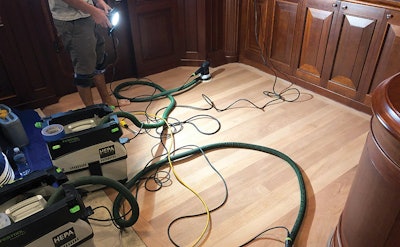
 Even when doing a complete refinish we use only hand-sanders, but they cut surprisingly well to bare wood once you find the right combination of abrasives with the right sequence. To better control the environment on this job, we had to tent off the entire area where we were working.
Even when doing a complete refinish we use only hand-sanders, but they cut surprisingly well to bare wood once you find the right combination of abrasives with the right sequence. To better control the environment on this job, we had to tent off the entire area where we were working.
The expectations aren't high, they are above high.
Everything on a yacht is very high end, and clients will get on their hands and knees to inspect the floor no matter how much you try to explain the industry standard of looking at the floor from a standing position. In a smaller space like that, people tend to notice everything. The more you can control the job in the beginning, the better you can deliver in the end.
Charge accordingly, and enjoy it.
Because the expectations are so high and the work can be so slow, you have to charge enough for your time. Overall, I love doing yacht work. It's very fun and cool to be on these boats, and I feel like the people respect us more than they do on a typical job site. Everyone who works on the yacht as their full-time job has to be a person who gets along with people, because they are out at sea together for days, weeks or months at a time. The captain has total control of how he runs his vessel, and he and his crew are very proud of what they do, from how the boat looks to how they arrange their lines next to the cleats on the dock. In general, you get more respect, the jobs are cleaner, the work is slower, they pay you better and it's a happier environment.
Al Carvalho is owner/operator at Max Hardwood Floors Corp. in Coral Springs, Fla.










